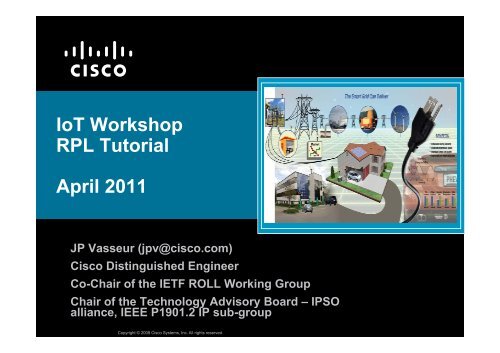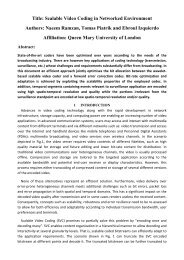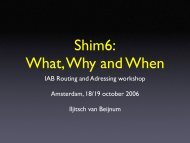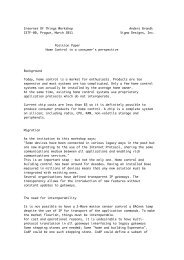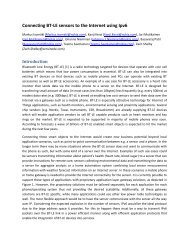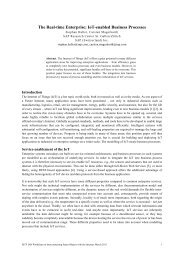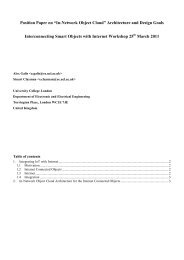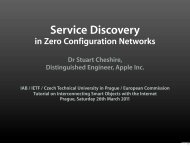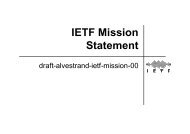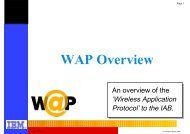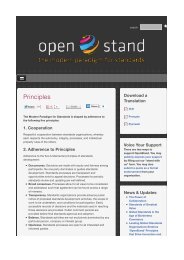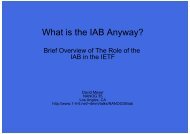IoT Workshop RPL Tutorial April 2011 - Internet Architecture Board
IoT Workshop RPL Tutorial April 2011 - Internet Architecture Board
IoT Workshop RPL Tutorial April 2011 - Internet Architecture Board
You also want an ePaper? Increase the reach of your titles
YUMPU automatically turns print PDFs into web optimized ePapers that Google loves.
<strong>IoT</strong> <strong>Workshop</strong><br />
<strong>RPL</strong> <strong>Tutorial</strong><br />
<strong>April</strong> <strong>2011</strong><br />
JP Vasseur (jpv@cisco.com)<br />
Cisco Distinguished Engineer<br />
Co-Chair of the IETF ROLL Working Group<br />
Chair of the Technology Advisory <strong>Board</strong> – IPSO<br />
alliance, IEEE P1901.2 IP sub-group<br />
Copyright © 2009 Cisco Systems, Inc. All rights reserved.
Where should Routing Take Place ?<br />
Historically, a number of interesting research initiatives on<br />
routing in WSN,<br />
Main focus on algorithms … a bit less on architecture<br />
Most work assuming the use of MAC addresses – L2<br />
“routing” (mesh-under)<br />
Support of multiple PHY/MAC is a MUST: IEEE 802.15.4,<br />
LP Wifi, PLC (number of flavors), …<br />
Layered architecture supporting multiple PHY/MAC, there<br />
aren’t that many options … IP !<br />
See the position paper on the “mesh under versus route<br />
over” debate – IETF ID to be published soon<br />
Copyright © 2009 Cisco Systems, Inc. All rights reserved.<br />
2
Routing Technical challenges in LLNs<br />
• Energy consumption is a major issue (for battery powered<br />
sensors/controllers),<br />
• Limited processing power<br />
• Very dynamic topologies:<br />
• Link failure (LP RF)<br />
• Node failures (triggered or non triggered)<br />
• Node mobility (in some environments),<br />
• Data processing usually required on the node itself,<br />
• Sometimes deployed in harsh environments (e.g. Industrial),<br />
• Potentially deployed at very large scale,<br />
• Must be self-managed (auto-discovery, self-organizing<br />
networks)<br />
100<br />
90<br />
80<br />
70<br />
60<br />
50<br />
40<br />
30<br />
20<br />
10<br />
0<br />
PDR Variation<br />
653<br />
2034<br />
3458<br />
5047<br />
6668<br />
8273<br />
9847<br />
11513<br />
13237<br />
14993<br />
16778<br />
18503<br />
20318<br />
22148<br />
24008<br />
25913<br />
27803<br />
29647<br />
31433<br />
34036<br />
Copyright © 2009 Cisco Systems, Inc. All rights reserved.<br />
8
“Classic” IP Networks are different<br />
• Routing protocols used in Service Providers’ network are link<br />
state<br />
• Scalability is a must but clearly not the same order of<br />
magnitude (most ISIS network are L2 flat)<br />
• Convergence time in these networks is key: ~ 10s of ms but<br />
link/node characteristics are quite different<br />
• Low BER<br />
• Immediate triggering (Link layer trigger or Fast KA (BFD)<br />
• Use of pre-configured backup path with FRR (IP/MPLS)<br />
• Use of dampening in case of rare link flaps<br />
• Mix of protection and restoration approach<br />
• No need for node metrics/constraints<br />
Copyright © 2009 Cisco Systems, Inc. All rights reserved.<br />
9
Lossy links are not just LP wireless …<br />
• PLC also quite challenging<br />
• Impedance variations, noise floor, K factor, …<br />
• Both LP wireless and PLC:<br />
• Very hard to model link behavior (even with G/G/K Markov<br />
Chain, no M and no D … )<br />
• Only valid model is real-data link profile from deployed<br />
networks<br />
Copyright © 2009 Cisco Systems, Inc. All rights reserved.<br />
10
How loosy is lossy ?<br />
Note just an increased BER<br />
Strong instabilities … that should be locally handled<br />
Fast global convergence via restoration in LLN would<br />
ineluctably lead to routing oscillation<br />
Under-react should be the rule …<br />
Copyright © 2009 Cisco Systems, Inc. All rights reserved.<br />
11
IETF – Routing Protocols<br />
Long history in developing routing protocols at the<br />
IETF:<br />
• RIP,<br />
• OSPF,<br />
• IS-IS,<br />
• BGP<br />
• MANET: AODV, OLSR, ...<br />
Copyright © 2009 Cisco Systems, Inc. All rights reserved.<br />
12
The <strong>Internet</strong> Engineering Task Force<br />
• New Routing WG (ROLL) formed for LLN in 2008"<br />
APS GEN OAM INT RTG RAI SEC TSV<br />
CoRE<br />
6lowpan<br />
Reuse whenever possible !<br />
ROLL<br />
Copyright © 2009 Cisco Systems, Inc. All rights reserved.<br />
13
Routing Over Low power and Lossy Link<br />
(ROLL) WG<br />
Working Group Formed in Jan 2008 and re-chartered once<br />
http://www.ietf.org/html.charters/roll-charter.html<br />
Co-chairs: JP Vasseur (Cisco), David Culler (Arch Rock)<br />
Mission: define Routing Solutions for LLN (Low power and Lossy<br />
Networks)<br />
Very active work with a good variety of participants<br />
Rechartered to specify the routing protocol for smart objects<br />
networks (after protocol survey)<br />
DT formed (and now dissolved)<br />
Several proposals: one of then adopted as WG document: <strong>RPL</strong><br />
Copyright © 2009 Cisco Systems, Inc. All rights reserved.<br />
14
IETF WG ROLL status as of today<br />
Work Items<br />
<strong>RPL</strong> is designed to support different LLN application requirements<br />
RFC 5548 - Routing requirements for Urban LLNs<br />
RFC 5673 - Routing requirements for Industrial LLNs<br />
RFC 5826 - Routing requirements for Home Automation LLNs<br />
RFC 5867 - Routing requirements for Building Automation LLNs<br />
Routing metrics for LLN: approved<br />
Produce a security Framework<br />
Protocol work: Specified in https://tools.ietf.org/html/draft-ietf-roll-rpl-19<br />
Applicability statement of ROLL routing protocols<br />
Timeline was key (in particular for SG).<br />
<strong>RPL</strong> <strong>Tutorial</strong><br />
Copyright © 2009 Cisco Systems, Inc. All rights reserved.<br />
15
Specific Routing Requirements<br />
Deliberate choice of 4 main application areas<br />
Support of unicast/anycast/multicast<br />
Adaptive routing with support of different metrics (latency,<br />
reliability, …)<br />
Support of constrained-based routing (energy, CPU, memory)<br />
Support of P2MP, MP2P and P2P with asymmetrical ECMP<br />
Scalability<br />
Discovery of nodes attributes (aggregator)<br />
0-config (Warning not to add too many options !)<br />
Performance: indicative (lesson learned from the <strong>Internet</strong>)<br />
Security<br />
Copyright © 2009 Cisco Systems, Inc. All rights reserved.<br />
16
Slide from IETF-72<br />
Copyright © 2009 Cisco Systems, Inc. All rights reserved.<br />
17
Slide from IETF-72<br />
Copyright © 2009 Cisco Systems, Inc. All rights reserved.<br />
18
Slide from IETF-72<br />
Copyright © 2009 Cisco Systems, Inc. All rights reserved.<br />
19
IETF ROLL WG Consensus<br />
Several routing protocols:<br />
Proactive: <strong>RPL</strong> (initial work by the Design Team)<br />
Reactive: DADR, …<br />
Strong WG consensus to adopt <strong>RPL</strong> as the routing<br />
protocol for LLN<br />
Copyright © 2009 Cisco Systems, Inc. All rights reserved.<br />
20
<strong>RPL</strong>: the IP Routing Protocol for Smart<br />
Objects<br />
Application Layer<br />
(HTTP, SMTP, FTP, SNMP,<br />
IMAP, DNS, …)<br />
Transport Layer<br />
(TCP, UDP, SCTP, RTP, …)<br />
<strong>Internet</strong> Layer IP<br />
(Routing, Multicast, QoS, …)<br />
In compliance with the layered architecture of<br />
IP, <strong>RPL</strong> does not rely on any particular<br />
features of a specific link layer technology.<br />
<strong>RPL</strong> is designed to be able to operate over a<br />
variety of different link layers, including ones<br />
that are constrained, potentially lossy, or<br />
typically utilized in conjunction with highly<br />
constrained host or router devices, such as but<br />
not limited to, low power wireless or PLC<br />
(Power Line Communication) technologies.<br />
Link Layer<br />
Physical Layer<br />
Copyright © 2009 Cisco Systems, Inc. All rights reserved.<br />
21
Protocol Design Choices<br />
Difficult tension between {flexibility, wide set of<br />
requirements, constrained devices}<br />
Option 1: take the union … Not a good choice …<br />
If at all possible not always a good choice to overload the protocol<br />
with features not used by the application<br />
An aspect that has been neglected by several protocol “Designers”<br />
Option 2: take the intersection and make the design<br />
modular <br />
Typically a subset of the <strong>RPL</strong> specification can be implement in<br />
light in the network requirement<br />
Allows for minimal footprint implementations<br />
Copyright © 2009 Cisco Systems, Inc. All rights reserved.<br />
22
<strong>RPL</strong> builds Directed Acyclic Graphs<br />
Tree would have been simpler but need for redundancy<br />
<strong>RPL</strong> supports the concept of DAG instances (a colored<br />
DAG), concept similar to MTR<br />
Allows a node to join multiple colored DAG with different<br />
Objective Functions<br />
And within an instance, there might be multiple DODAG<br />
(Destination Oriented DAG)<br />
A node may belong to more than one <strong>RPL</strong> instance<br />
Packets are tagged to follow a specific instance (defined at<br />
the application layer): no loops between instances<br />
Copyright © 2009 Cisco Systems, Inc. All rights reserved.<br />
23
<strong>RPL</strong> Message Types<br />
<strong>RPL</strong> Control message are ICMPv6 messages<br />
<strong>RPL</strong> message={Base, Options}<br />
DIS: DODAG Information Solicitation<br />
DIO: DODAG Information Object<br />
DAO: Destination Advertisement Object<br />
DAO-ACK: Destination Advertisement Object<br />
Acknowledgement<br />
+ The 4 secured versions<br />
Link-local scope: source is link-local unicast and destination=link-local<br />
unicast or all-<strong>RPL</strong>-nodes(FF02::1) (for all <strong>RPL</strong> messages except DAO/<br />
DAO-ACK in non storing mode, DIO replies to DIS)<br />
Copyright © 2009 Cisco Systems, Inc. All rights reserved.<br />
30
Building a DAG –<br />
Upward routing<br />
Copyright © 2009 Cisco Systems, Inc. All rights reserved.<br />
31
Physical Network<br />
3<br />
LBR<br />
1.5<br />
1.3<br />
Step 3<br />
X<br />
ETX (=1 when not indicated)<br />
=> reflect the link quality<br />
Battery operated node used a<br />
(hard) constraint<br />
11 12 13<br />
1.1<br />
1.8<br />
1.3<br />
2<br />
1<br />
1.6<br />
1.7<br />
LBR<br />
21<br />
1.1 2.9 1.9<br />
22<br />
4<br />
2.5<br />
23<br />
24<br />
1.4 1.3<br />
*<br />
2.1<br />
2.2 2.4 2.7<br />
31 32<br />
33<br />
34<br />
35<br />
41 42 43<br />
44<br />
45<br />
4<br />
46<br />
11 12 13<br />
21<br />
22<br />
23 24<br />
The DAG (Direct Acyclic Graph) continues to build<br />
Step 1<br />
LBR<br />
DIO message multicasted to all-<br />
<strong>RPL</strong>-nodes by the root<br />
Final<br />
LBR<br />
3<br />
1.5<br />
1.3<br />
11 12 13<br />
11 12 1.8 13<br />
1.1<br />
2<br />
1<br />
1.6<br />
1.7<br />
Step 2<br />
LBR<br />
21<br />
1.9<br />
22<br />
2.5<br />
23<br />
24<br />
1.4 1.3<br />
11 12 13<br />
Router runs an algorithm to choose a parent based on an objective and<br />
metrics/constraint (best quality path, highest bandwidth link,….)<br />
2.4 2.7 *<br />
31 32 33 34 35<br />
41 42 43 44 45 46
The <strong>RPL</strong> DIO Message<br />
G: Grounded<br />
<strong>RPL</strong>InstanceID Version Rank<br />
G 0 MOP Prf DTSN Flags Reserved<br />
DODAGID<br />
Options<br />
Option<br />
Type Length Data …<br />
MOP:<br />
0: no Downward route<br />
1: Non Storing Mode<br />
2: Storing without Multicast<br />
3: Storing with Multicast<br />
DTSN: set by the<br />
node issuing the<br />
DIO used to<br />
maintain DAO<br />
routes<br />
Copyright © 2009 Cisco Systems, Inc. All rights reserved.<br />
34
<strong>RPL</strong> Option DODAG Configuration Option<br />
DODAG Configuration (in DIO): unchanged by intermediate<br />
nodes, sent occasionally (always upon receiving DIS)<br />
Parameters<br />
controlled by<br />
root<br />
Path Control Size:<br />
#bits of Path<br />
Control Field<br />
DagMaxRankIncrease<br />
may be used by<br />
Local Reprair<br />
Type=4 Length=14 Flag A PCS DIOIntDbl<br />
DIOIntMin DIORund MaxRankIncrease<br />
MinHopRankIncrease<br />
OCP<br />
Reserved Def Lifetime Lifetime Unit<br />
DIOIntDbl: DIOInterdoubling<br />
DIOIntervalMin: Imin<br />
DIORund: K<br />
Default Lifetime for all <strong>RPL</strong><br />
routes<br />
Example of a <strong>RPL</strong> option<br />
Copyright © 2009 Cisco Systems, Inc. All rights reserved.<br />
38
Physical topology<br />
Concept of Multiple <strong>RPL</strong> Instances (a la MTR)<br />
5<br />
LBR<br />
10<br />
10<br />
Battery Operated Node<br />
11 12 13<br />
80<br />
50<br />
5<br />
20<br />
10<br />
10<br />
10<br />
21<br />
22<br />
23 24<br />
5<br />
10 10<br />
10 20<br />
10<br />
10 10 20<br />
31 32 33 34 35<br />
X<br />
Poor Quality (LQL=3)<br />
Fair Quality (LQL=2)<br />
Good Quality (LQL=1)<br />
Latency in milliseconds<br />
DAG Instance 1: high quality – no battery operated nodes<br />
DAG Instance 2: low latency<br />
LBR<br />
LBR<br />
11 12 13<br />
11<br />
12 13<br />
21<br />
22<br />
23<br />
24<br />
21<br />
22<br />
23<br />
24<br />
31 32 33 34 35<br />
<strong>RPL</strong> instance 1<br />
31 32 33 34 35<br />
<strong>RPL</strong> instance 2
Routing Metrics used by<br />
<strong>RPL</strong><br />
Copyright © 2009 Cisco Systems, Inc. All rights reserved.<br />
40
Use of adaptive routing metrics …<br />
Today’s IGP use static link metrics<br />
Administrative cost or polynomial cost<br />
Using dynamic metric is not a new idea (experimented<br />
in ARPANET-II based on average queue lenght)<br />
Hard to control … routing oscillations<br />
Issue with too frequent control traffic in LLN<br />
Copyright © 2009 Cisco Systems, Inc. All rights reserved.<br />
41
Routing Metrics in LLNs<br />
Specified in draft-ietfroll-routing-metrics<br />
Node Metrics<br />
Node State and Attributes Object<br />
Purpose is to reflects node workload (CPU,<br />
Memory…)<br />
“O” flag signals overload of resource<br />
“A” flag signal node can act as traffic<br />
aggregator<br />
Node Energy Object<br />
“T” flag: Node type: 0 = Mains, 1 = Battery, 2 =<br />
Scavenger<br />
“I” bit: Use node type as a constraint (include/<br />
exclude)<br />
“E” flag: Estimated energy remaining<br />
Hop Count Object<br />
Constraint - max number of hops that can be<br />
traversed<br />
Metric - total number of hops traversed<br />
Object can be used as metric and/or<br />
constraint - metric can be additive/max/..<br />
Link Metrics<br />
Throughput Object<br />
Currently available throughput (Bytes per<br />
second)<br />
Throughput range supported<br />
Latency<br />
Constraint - max latency allowable on path<br />
Metric - additive metric updated along path<br />
Link Reliability<br />
Link Quality Level Reliability (LQL)<br />
0=Unknown, 1=High, 2=Medium, 3=Low<br />
Expected Transmission Count (ETX)<br />
(Average number of TX to deliver a<br />
packet)<br />
Link Colour<br />
Metric or constraint, arbitrary admin value<br />
Copyright © 2009 Cisco Systems, Inc. All rights reserved.<br />
43
The <strong>RPL</strong> Objective Function<br />
An objective function defines how nodes perform parent<br />
selection and how to compute rank based on metrics<br />
Defined by the OCP<br />
Combined with metrics/constraints<br />
“Use the LQL as a global recorded metric and favor paths with the<br />
minimum number of low and fair quality links, use the link color as a link<br />
constraint to avoid non encrypted links”.<br />
“Find the best path in term of latency (link latency is used as a global<br />
aggregated metric), while avoiding poor quality links and battery<br />
operated nodes”.<br />
See OF0 and MRHOF<br />
Copyright © 2009 Cisco Systems, Inc. All rights reserved.<br />
45
Mode of Operation<br />
Parent selection governed by OF, decoupled from metrics<br />
and constraints<br />
Node leaving a DODAG should remember the DODAG<br />
parameters for some period of time to avoid rejoining a node<br />
in a former sub-DAG, thus avoiding loops.<br />
DODAGVersion governed by DAGroot according to<br />
implementation specific events<br />
A node with DODAG parent set =={} may set G bit (with<br />
lower Pref)<br />
DODAG selection is also implementation-specific<br />
Copyright © 2009 Cisco Systems, Inc. All rights reserved.<br />
46
Mode of Operation (Cont’)<br />
Movement within a DAG<br />
Node may jump to a parent with a lower rank<br />
Within a DODAG a node cannot advertise a rank L>L<br />
+DAGMaxRankIncrease (RANK=INFINITY is an exception)<br />
Node can select any parent advertising a higher DODAGVersion<br />
Node can at any time join a different DODAG within the same <strong>RPL</strong><br />
instance with no rank restriction (except if the node used to belong to this<br />
DODAG Version)<br />
If a node needs to move down it MAY poison its sub-DAG<br />
Poisoning<br />
Means sending DIO with Rank=INFINITY<br />
Node cannot select a parent advertising a Rank=Infinity<br />
Still a node may detach without poisoning by setting the G Flag<br />
Copyright © 2009 Cisco Systems, Inc. All rights reserved.<br />
47
Mode of Operation (Cont)<br />
A node should prefer to stay in its DODAG via an alternate<br />
parent if any should the preferred parent have left its DODAG<br />
DIO transmission is governed by Trickle Timer<br />
Reception of DIO from less DAGRank causing no change to<br />
DODAG parent set, preferred parents, Rank, reception of<br />
unicast DIS, => consistent<br />
Trickle timer reset upon inconsistency detection:<br />
Packet forwarding error (Rank-error, Forwarding-error, …)<br />
Reception of DIS with all predicates==true<br />
New DODAGVersion (new DODAGVersionNumber, new <strong>RPL</strong><br />
Instance)<br />
See Trickle Algorithm – next slide<br />
Copyright © 2009 Cisco Systems, Inc. All rights reserved.<br />
49
The use of Trickle Timers<br />
The basic idea is to suppress redundant messages (key when<br />
resources such as energy and bandwidth are scarce)<br />
Here is the algorithm:<br />
I: Current length of the communication interval,<br />
T: Timer value. T is in the range [I, I/2]<br />
C: Redundancy counter<br />
K: Redundancy constant<br />
I min : Smallest value of I<br />
I doubling : The number of times is doubled before maintaining a<br />
constant multicast rate.<br />
I max : Largest value of I max = I min * 2 Idoubling .<br />
When T fires, if C>K, then send DIO, then upon expiration of I,<br />
compute new(I) and T.<br />
Detection of inconsistency => Trickle timer reset<br />
Nodes may increment C if they receive consistent messages<br />
Copyright © 2009 Cisco Systems, Inc. All rights reserved.<br />
50
Trickle at works …<br />
<strong>RPL</strong> Traffic Waves – reset trickle timers)<br />
Copyright © 2009 Cisco Systems, Inc. All rights reserved.<br />
51
<strong>RPL</strong> DIS message and Option<br />
Base Format:<br />
Flags Reserved Option …<br />
Allows for predicate to solicit replies from subset of nodes<br />
V: Version predicate<br />
Receiver DOAGVersion=Version?<br />
I: InstanceID predicate<br />
Receiver <strong>RPL</strong>InstanceID=<strong>RPL</strong>InstanceID ?<br />
Type=7 Option Length=19 <strong>RPL</strong>InstanceID V I D Flags<br />
DODAGID<br />
Version num<br />
Used to solicit a DIO from a <strong>RPL</strong><br />
node in the vicinity<br />
Ability to add filtering to the request<br />
to limit the number of replies (use<br />
of predicates)<br />
Copyright © 2009 Cisco Systems, Inc. All rights reserved.<br />
D: DODAGID predicate<br />
Receiver DODAGID=DODAGID?<br />
Node reset trickle timer when all predicates are true.<br />
53
Operation as a leaf node<br />
As with many other protocol, refers to the ability to participate<br />
to the routing domain, without forwarding <strong>RPL</strong> traffic.<br />
Governed by policy or upon receiving unsupported/<br />
unrecognized OF/Metric/Constraint<br />
Send DIO in very specific circumstances (transition – node<br />
was part of another DODAG receiving packet for old<br />
topology) with RANK=Inifinite<br />
May unicast transmit DAO or multicast DAO for 1-hop<br />
optimization<br />
Copyright © 2009 Cisco Systems, Inc. All rights reserved.<br />
54
Downward routing<br />
Copyright © 2009 Cisco Systems, Inc. All rights reserved.<br />
55
Storing Versus Non-Storing Mode<br />
<strong>RPL</strong> supports two modes (mix not allowed):<br />
Storing mode: nodes do store/maintain routing tables<br />
Non-storing mode: nodes use default routing upward and source routing<br />
downward<br />
Upward routing similar<br />
Differences in downward routing:<br />
Storing mode: packets travel up to a common ancestor<br />
Non storing mode: packets travel up to the DAG root, then source routed<br />
Impact on forwarding:<br />
Use of source routing in non-storing<br />
No use of <strong>RPL</strong> option header (no risk of loops) in non-storing<br />
Copyright © 2009 Cisco Systems, Inc. All rights reserved.<br />
56
Populating the Routing Tables<br />
DAG provides UP connectivity<br />
Requires DOWN connectivity (routes toward the<br />
leaves)<br />
<strong>RPL</strong> specifies DAO messages used to advertize<br />
prefixes to parents (storing) or DAGRoot (non-storing)<br />
Nodes capable of storing the prefixes populate their<br />
routing tables<br />
Packets are routed up to a common ancestor for P2P<br />
routing with an optimization for 1-hop reachable nodes<br />
Copyright © 2009 Cisco Systems, Inc. All rights reserved.<br />
57
The <strong>RPL</strong> DAO Message<br />
++ each time a DAO is issued,<br />
used in DAO-ACK (unique to<br />
each node)<br />
<strong>RPL</strong>InstanceID K D Flags Reserved DAO Sequence<br />
* DODAGID<br />
Options<br />
Set if DAO-ACK<br />
requested<br />
D=1 if DODAGID is<br />
present (when<br />
Local<strong>RPL</strong>Instance<br />
ID is used)<br />
Copyright © 2009 Cisco Systems, Inc. All rights reserved.<br />
58
<strong>RPL</strong> Option: Target<br />
<strong>RPL</strong> Target (may be in DAO): indicates reachability.<br />
Transit Information (may be in DAO): may contain Parent address for an<br />
ancestor used with source routing (could be one Transit info per DAO<br />
parent for non-storing). A Path Control field used for non storing to<br />
influence the reverse path.<br />
++ each time issuing<br />
a Target<br />
E: External route<br />
Type=6 Option Length E Flags Path Control<br />
Path Seq<br />
Path Lifetime<br />
Parent Address *<br />
Path Control: Number of 1-bit fields specified in PCS of DODAG config (DIO).<br />
Copyright © 2009 Cisco Systems, Inc. All rights reserved.<br />
59
Populating the routing tables using DAO<br />
message<br />
Two modes of operations: storing mode and non storing<br />
modes<br />
DAO<br />
LBR<br />
3<br />
1.5<br />
1.3<br />
STORING MODE<br />
DAO<br />
LBR<br />
3<br />
1.5<br />
NON STORING MODE<br />
1.3<br />
11 12 1.8 13<br />
1.1<br />
2<br />
1<br />
1.7<br />
11 12 1.8 13<br />
1.1<br />
2<br />
1<br />
1.7<br />
21<br />
1.9<br />
22<br />
2.5<br />
23<br />
24<br />
1.4 1.3<br />
21<br />
1.9<br />
22<br />
2.5<br />
23<br />
24<br />
1.4 1.3<br />
2.4 2.7 *<br />
31 32 33 34 35<br />
2.4 2.7 *<br />
31 32 33 34 35<br />
41 42 43 44 45 46<br />
Unicast to DAO parents<br />
Copyright © 2009 Cisco Systems, Inc. All rights reserved.<br />
41 42 43 44 45 46<br />
Unicast to DODAG Root (not<br />
processed by intermediate nodes)<br />
63
Triggering Multicast DAO for 1-hop<br />
routing<br />
Node may multicast DAO using link local all-<strong>RPL</strong>-node<br />
Used only to advertise information about the node itself (prefixes directly<br />
connected or owned by the node itself)<br />
MUST NOT be used to relay information using unicast DAO<br />
Usually preferred than routes learned through unicast DAO<br />
LBR<br />
3<br />
1.5<br />
1.3<br />
STORING MODE<br />
11 12 1.8 13<br />
1.1<br />
2<br />
1<br />
1.7<br />
21<br />
1.9<br />
22<br />
2.5<br />
23<br />
24<br />
1.4 1.3<br />
2.4 2.7 *<br />
31 32 33 34 35<br />
41 42 43 44 45 46<br />
Copyright © 2009 Cisco Systems, Inc. All rights reserved.<br />
66
Loops in DODAG:<br />
detection and repairs<br />
Copyright © 2009 Cisco Systems, Inc. All rights reserved.<br />
67
Potential Loops<br />
Loops in DV are hardly avoidable (due to control message<br />
loss and sibling routing)<br />
Tension between Loops avoidance and loop detection<br />
<strong>RPL</strong> supports both<br />
E.g. Rules about the rank: do not attach to a node deeper in the DAG<br />
E.g. Set flags in the packet header to detect loops that may occur<br />
(datapath validation)<br />
When loop could occur ?<br />
DIO/DAO message loss is the most common example …<br />
<strong>RPL</strong> makes use of on-demand loop detection with data<br />
packets (e.g. rank of sender and direction are used for loop<br />
detection)<br />
Copyright © 2009 Cisco Systems, Inc. All rights reserved.<br />
68
Loop Detection<br />
Idea: add flags to data packets to detect and breaks loops<br />
Receiving a packet with inconsistent flag according to the rank is a loop<br />
indication (Set to INFINITY when moving to new DODAGVersion)<br />
DAG inconsistency loop detection:<br />
O=1 from a node with higher Rank<br />
O=0 from a node with a lower rank<br />
Once an inconsistency is detected, the R bit is set. Upon receiving a<br />
packet with R=1, the packet MUST be dropped and trickle reset.<br />
O R F 0 0 0 0 0 <strong>RPL</strong>InstanceID<br />
Option Type<br />
Sender Rank<br />
Opt Data Len<br />
Sub-TLVs<br />
O: Down bit; R: Rank-error bit; F: Forwarding Error bit => Expected to change en-route<br />
(packet MUST be discarded if <strong>RPL</strong> option header not understood)<br />
<strong>RPL</strong> Option header (IPv6 Hop-by-hop header) immediately following the IPv6 header<br />
Copyright © 2009 Cisco Systems, Inc. All rights reserved.<br />
70
DAO inconsistency detection and<br />
recovery<br />
Only for storing mode (use of ICMP “Error in source routing<br />
Header” in non-storing mode)<br />
Upon reception of a packet with no-route, sent it back with<br />
F=1 to clean-up state.<br />
Copyright © 2009 Cisco Systems, Inc. All rights reserved.<br />
71
DODAG Maintenance<br />
and Repairs<br />
Copyright © 2009 Cisco Systems, Inc. All rights reserved.<br />
73
Global versus Local Repair<br />
Global repair: rebuilt the DAG … requires a new DAG<br />
Sequence number generated by the root<br />
Triggered by the root<br />
Potentially signaled to the root (under investigation)<br />
Local Repair: find a “quick” local repair path<br />
Only requiring local changes !<br />
May not be optimal according to the OF and overall DAG<br />
shape, which is fine<br />
Complementary approaches<br />
Copyright © 2009 Cisco Systems, Inc. All rights reserved.<br />
75
Step 0<br />
Root<br />
Step 2<br />
11 12 13<br />
11 12 13<br />
21<br />
22<br />
23<br />
24<br />
21<br />
22<br />
23<br />
31 32 33 34 35<br />
36<br />
31 32 33 34 35<br />
41 42 43 44 45 46<br />
Root<br />
Step 1<br />
41 42 43 44 45 46<br />
36<br />
24<br />
11 12 13<br />
21<br />
22<br />
23<br />
24<br />
DIO poisoning<br />
31 32 33 34 35<br />
36<br />
41 42 43 44 45 46
Remember the DAGMaxRankIncrease ?<br />
Before moving down, remember the rank r<br />
Do not attach to any node with rank>r+H<br />
This help reduce the size of infinity <br />
Let L be the lowest rank within a DODAG Version that a given node<br />
has advertised. Within the same DODAG Version, that node MUST<br />
NOT advertise an effective rank higher than L +<br />
DAGMaxRankIncrease. INFINITE_RANK is an exception to this rule:<br />
a node MAY advertise an INFINITE_RANK within a DODAG version<br />
without restriction. If a node's Rank were to be higher than allowed by<br />
L + DAGMaxRankIncrease, when it advertises Rank it MUST<br />
advertise its Rank as INFINITE_RANK.<br />
Copyright © 2009 Cisco Systems, Inc. All rights reserved.<br />
77
Step 0<br />
Root<br />
Repair diameter: all<br />
nodes with a rank=1+3<br />
11 12 13<br />
21<br />
22<br />
23<br />
24<br />
31 32 33 34 35<br />
36<br />
SenderRank=2, <br />
O=1 => loop ! <br />
Reset Trickle CTI <br />
Root<br />
Worst<br />
Case<br />
41 42 43 44 45 46<br />
Best<br />
Case<br />
21<br />
Root<br />
11 13<br />
22<br />
23<br />
24<br />
11 5 12 13 Loop !<br />
2 <br />
21 22 5 23 24<br />
6 <br />
8 <br />
3 <br />
24<br />
31 7 32 33 34 35 36<br />
4 <br />
12<br />
31 32 33 34 35<br />
36<br />
41 42 43 44 45 46<br />
41 42 43 44 45 46
Forwarding in LLN<br />
Copyright © 2009 Cisco Systems, Inc. All rights reserved.<br />
79
Forwarding<br />
Two related drafts (Passed Working Last Call):<br />
• draft-ietf-6man-rpl-option<br />
– <strong>RPL</strong> information in data-plane with IPv6 Hop-by-Hop Option<br />
• draft-ietf-6man-rpl-routing-header<br />
– Source routes for non-storing mode with IPv6 Routing Header<br />
Copyright © 2009 Cisco Systems, Inc. All rights reserved.<br />
80
Some Simulation<br />
Results<br />
Copyright © 2009 Cisco Systems, Inc. All rights reserved.<br />
87
Simulation Results<br />
Based on Omnet++ (Discrete Event simulator) / Castalia<br />
(Wireless) – Radio: TelosB CC2420 with 15.4 links.<br />
No formal Markov chain modeling: capture of thousands on link<br />
traces capturing topologies and PDR/RSSI, both in-door and<br />
outdoor. Additional Markov Chain for link failures.<br />
Trickle used with I_min=1s and I_doubling (Max=18.2 hours)<br />
Most traffic simulated MP2P(80%), CBR, Metric=ETX (other<br />
simulation for building automation)<br />
Simulations can be quite useful to find issues, not to<br />
demonstrate that a protocol actually works…<br />
Copyright © 2009 Cisco Systems, Inc. All rights reserved.<br />
88
Simulation Results<br />
Path Cost stretch using ETX as metric (specifically for building: 60% 1-hop, 20%<br />
2-hop, 20% uniformly distributed).<br />
Copyright © 2009 Cisco Systems, Inc. All rights reserved.<br />
89
Simulation Results – Routing Stability<br />
Number of parents flipping<br />
Fraction of path change<br />
Number of flipping of parents<br />
120<br />
100<br />
80<br />
60<br />
40<br />
20<br />
Comparison of Parent flipping at different tolerance of metric distance change<br />
CDF in %age<br />
100<br />
90<br />
80<br />
70<br />
60<br />
50<br />
40<br />
30<br />
Fractional Metric distances 0% Tolerance stretch for different tolerance<br />
10% Tolerance<br />
20% Tolerance<br />
0% Tolerance<br />
10% Tolerance<br />
20% Tolerance<br />
20<br />
0<br />
0 5<br />
10<br />
10 15 20 25<br />
Average depth of a node<br />
0<br />
0 0.05 0.1 0.15 0.2 0.25 0.3<br />
Fractional Metric Distance Stretch<br />
Path Cost Stretch<br />
Copyright © 2009 Cisco Systems, Inc. All rights reserved.<br />
90
Simulation Results – Routing Stability<br />
End-to-End Latency<br />
100<br />
90<br />
80<br />
Comparison of End to End latency for different hop count<br />
=6 hops<br />
CDF of Delay in %age<br />
70<br />
60<br />
50<br />
40<br />
30<br />
20<br />
10<br />
0<br />
10 −2 10 −1 10 0<br />
Delay in seconds<br />
Copyright © 2009 Cisco Systems, Inc. All rights reserved.<br />
91
Is <strong>RPL</strong> Ready for “prime time” ?<br />
• Lots of ideas coming from deployed networks<br />
• More than 15 implementations including several<br />
commercial products this year<br />
• Stable specification (One last IESG DISCUSS,<br />
Routing metrics, trickle approved)<br />
• Two interoperability test events took place (earlier<br />
revision):<br />
• IPSO (Storing mode)<br />
• Zigbee/IP (Non-Storing modes)<br />
– Adopted by Industry alliances: Zigbee/IP,<br />
Wavenis, IEEE P1901.2, …<br />
Copyright © 2009 Cisco Systems, Inc. All rights reserved.<br />
92
Is <strong>RPL</strong> Lightweight ?<br />
<strong>RPL</strong> has been designed to be MODULAR<br />
RAM and Flash usage figures of four independent<br />
implementations<br />
10<br />
9<br />
8<br />
7<br />
6<br />
5<br />
4<br />
3<br />
2<br />
1<br />
0<br />
Flash<br />
RAM<br />
Flash<br />
A<br />
B<br />
C<br />
D<br />
RAM<br />
Copyright © 2009 Cisco Systems, Inc. All rights reserved.<br />
93
Potential Future items<br />
Applicability statements<br />
ROLL re-chartering discussion<br />
Potential candidates<br />
Lightweight security<br />
Label Switching (Label distribution, Forwarding !)<br />
“Routing Admission control”<br />
Path Computation Element<br />
Copyright © 2009 Cisco Systems, Inc. All rights reserved.<br />
94
Thank you for<br />
your attention<br />
Copyright © 2009 Cisco Systems, Inc. All rights reserved.
Cisco Confidential<br />
Copyright © 2009 Cisco Systems, Inc. All rights reserved.


